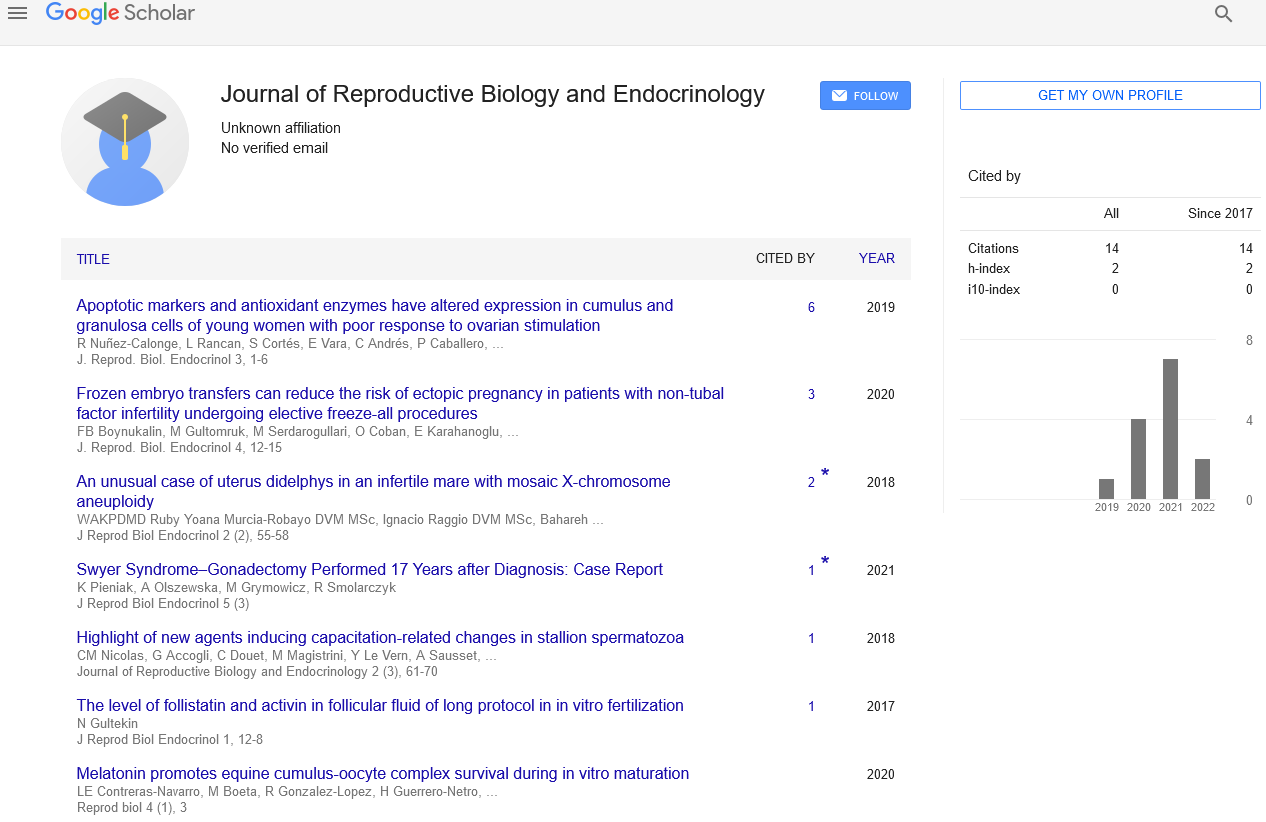Clinical implications on uterine fibroids
Received: 13-Sep-2021 Accepted Date: Sep 27, 2021; Published: 04-Oct-2021
Citation: Greco C. Clinical implications on uterine fibroids. J Reprod Biol Endocrinol. 2021;5(5):5
This open-access article is distributed under the terms of the Creative Commons Attribution Non-Commercial License (CC BY-NC) (http://creativecommons.org/licenses/by-nc/4.0/), which permits reuse, distribution and reproduction of the article, provided that the original work is properly cited and the reuse is restricted to noncommercial purposes. For commercial reuse, contact reprints@pulsus.com
Description
Uterine fibroids area unit a typical kind of noncancerous growth that may grow in and on your female internal reproductive organ. Not all fibroids cause symptoms, however after they do, symptoms will embrace serious catamenial hemorrhage, back pain, frequent evacuation and pain throughout sex. Little fibroids usually don’t want treatment, however larger fibroids are often treated with medications or surgery.
Uterine fibroids (also referred to as leiomyomas) area unit growths created from the muscle and animal tissue from the wall of the female internal reproductive organ. These growths area unit sometimes not cancerous (benign). Your female internal reproductive organ is Associate in nursing the wrong way up pear-shaped organ in your pelvis. The traditional size of your female internal reproductive organ is analogous to a lemon [1]. It’s additionally referred to as the female internal reproductive organ and it’s the place wherever a baby grows and develops throughout gestation. Fibroids will grow as one nodule (one growth) or during a cluster.
Fibroid clusters will target size from one millimetre to quite twenty cm (8 inches) in diameter or perhaps larger. For comparison, they will get as giant because the size of a watermelon. These growths will develop among the wall of the female internal reproductive organ, within the most cavities of the organ or perhaps on the outer surface. Fibroids will vary in size, range and site among and on your female internal reproductive organ [2]. You may expertise a range of symptoms with female internal reproductive organ fibroids and these might not be identical symptoms that another girl with fibroids can expertise. Attributable to however distinctive fibroids are often, your treatment set up can rely upon your individual case [3].
Who is in danger for female internal reproductive organ fibroids?
There are a unit many risk factors that may play a task in your probabilities of developing fibroids. These will include:
• Obesity and a better weight (a person is taken into account rotund if they’re quite two hundredth over the healthy body weight).
• Family history of fibroids.
• Not having youngsters.
• Early onset of menstruum (getting your amount at a young age).
• Late age for climacteric.
There are a unit many places each within and outdoors of your female internal reproductive organ wherever fibroids will grow. The placement and size of your fibroids is vital for your treatment. Wherever your fibroids area unit growing, however huge they’re and the way several of them you’ve got can verify which sort of treatment can work best for you or if treatment is even necessary [4]. There are unit completely different names given for the places your fibroids area unit set in and on the female internal reproductive organ. These names describe not solely wherever the fibroid is, however however it’s hooked up. Specific locations wherever you’ll have female internal reproductive organ fibroids include:
Submucosal fibroids: during this case, the fibroids area unit growing within the female internal reproductive organ house (cavity) wherever a baby grows throughout gestation. Consider the growths extending down into the empty house within the middle of the female internal reproductive organ.
Intramural fibroids: These fibroids area unit embedded into the wall of the female internal reproductive organ itself. Image the perimeters of the female internal reproductive organ like walls of a house. The fibroids area unit growing within this muscular wall.
Subserosal fibroids: set on the surface of the female internal reproductive organ now, these fibroids area unit connected closely to the surface wall of the female internal reproductive organ.
Pedunculated fibroids: the smallest amount common sort, these fibroids also are set on the surface of the female internal reproductive organ. However, pedunculated fibroids area unit connected to the female internal reproductive organ with a skinny stem. They’re usually delineate as mushroom-like as a result of they need a stalk and so a far wider high.
Symptoms of female internal reproductive organ fibroids
Most fibroids don’t cause any symptoms and don’t need treatment apart from regular observation by your care supplier. These area unit generally little fibroids. Once you don’t expertise symptoms, it’s referred to as Associate in nursing symptomless fibroid. Larger fibroids will cause you to expertise a range of symptoms, including:
• Excessive or painful hemorrhage throughout your amount (menstruation).
• Bleeding between your periods.
• A feeling of fullness in your lower abdomen/bloating.
• Frequent evacuation (this will happen once a fibroid puts pressure on your bladder).
• Pain throughout sex.
• Low back pain.
• Constipation. • Chronic emission.
• Inability to urinate or fully empty your bladder.
• Increased abdominal distention (enlargement), inflicting your abdomen to seem pregnant.
The symptoms of female internal reproductive organ fibroids sometimes stabilize or flee once you’ve more responsible climacteric as a result of secretion levels decline among your body.
References
- De La Cruz MS, Buchanan EM. Uterine Fibroids: Diagnosis and Treatment. Am Fam Physician. 2017;95(2):100-07.
- Giuliani E, As-Sanie S, Marsh EE. Epidemiology and management of uterine fibroids. Int J Gynaecol Obstet. 2020;149(1):3-9. Stewart EA, Laughlin-Tommaso SK, Catherino WH, et al. Uterine fibroids. Nat Rev Dis Primers. 2016;2:16043.
- Al-Hendy A, Myers ER, Stewart E. Uterine Fibroids: Burden and Unmet Medical Need. Semin Reprod Med. 2017;35(6):473-80.
- Grube M, Neis F, Brucker SY, et al. Uterine Fibroids - Current Trends and Strategies. Surg Technol Int. 2019;34:257-63





